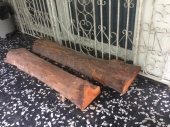I am not sure if you are designing the entire resort or a greywater system for an existing facility?
Could you provide more details on the resort such as existing facilities and/or infrastructure, layout of the resort (type of facilities, number of buildings, cabins etc.), area(s) available for the greywater treatment areas, general topography and elevations of the area, plans for future expansion etc. Also your location would be useful to understand climate considerations and regulations that may apply.
The amount of water I would like to process is 5000L (15 min duration) at peak use that is water from the wash basin, shower and laundry. Total grey water per day is estimated at 15,000L.
Could you provide information on how you arrived at these numbers? The peak seems high to me...1/3 of total daily estimate used in 15 min? The daily estimate works out to around 180 L/guest/day, again this may be a little high/conservative as I am assuming that the necessity to truck in water would result in water conservation priority in design of plumbing fixtures and overall water usage practices at the resort?
If the greywater collection plumbing has not been constructed, it would be worth considering individual at-source treatment systems, provided you are in an area where regulations are not strict or non-existent. For example:
- Individual or small groups of bathroom sinks/showers directed to small treatment systems comprised of mulch basins
- Laundry facilities could have a dedicated system based on number of machines and expected useage
- Kitchen and food prep areas could have a dedicated system - it would be best to use a mulch/wood chip filter to remove food particles and grease (or a conventional grease trap) prior to discharge to greywater treatment system or any collection plumbing infrastructure.
There are several possible advantages of this strategy:
- You may be able to save significant cost on plumbing materials and installation compared to conventional collection plumbing of all facilities to one treatment area.
- Each system could be designed specifically for the type of greywater to be treated, and would make planning for daily flow rates and peak events would be simpler, with less risk of over or under estimating the actual flows.
- smaller easier designs for planning, installation and maintenance - would also be able to be more discretely incorporated into the landscaping plan
- facilitate future alterations to the system as individual areas can be maintained/modified/expanded on a smaller simpler scale.
- Easier troubleshooting of system issues
- mitigation of system failures. If a combined system fails, the entire resort is affected, where as individual system failure would only affect those locations where the issue has occured.





